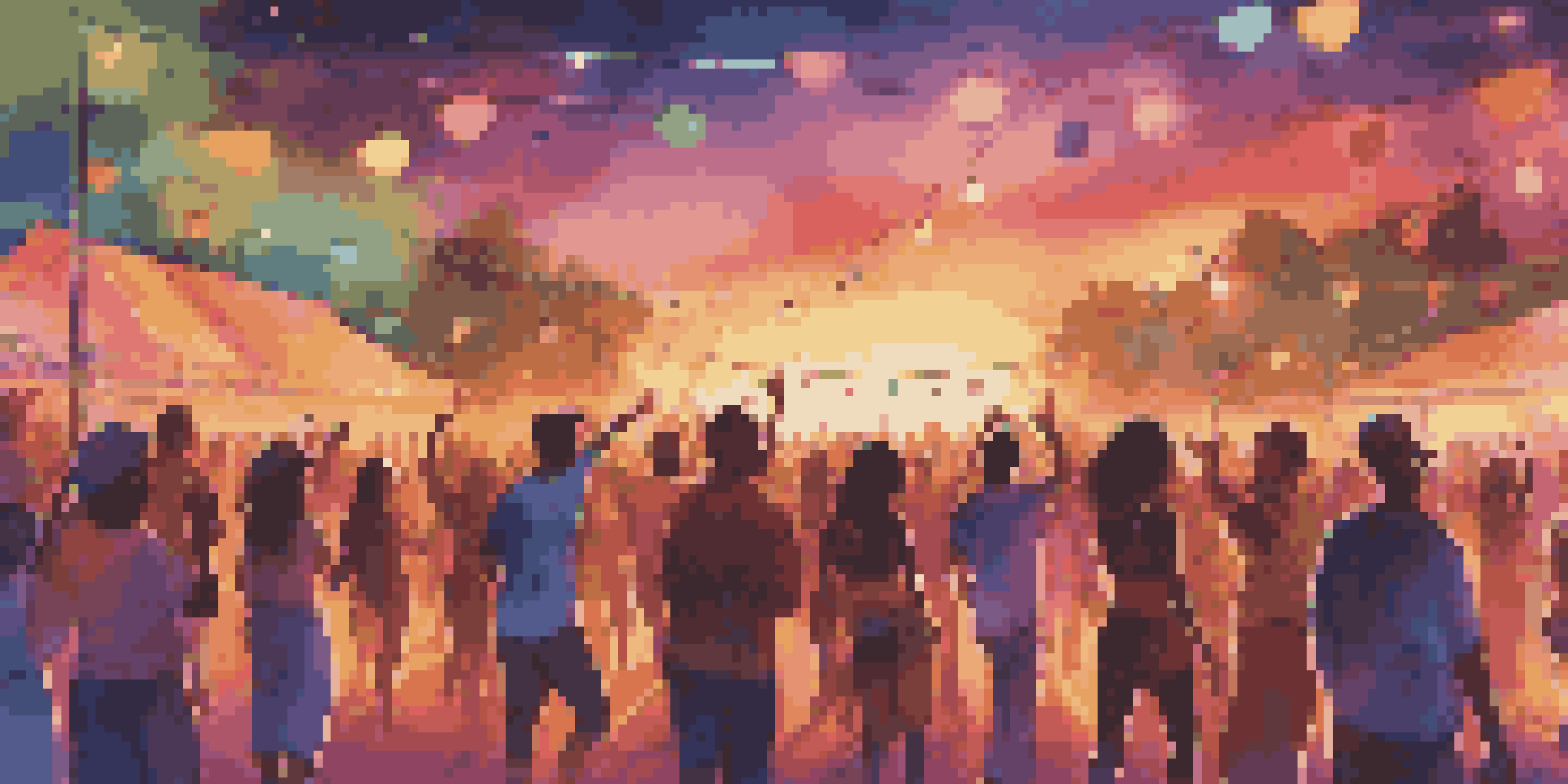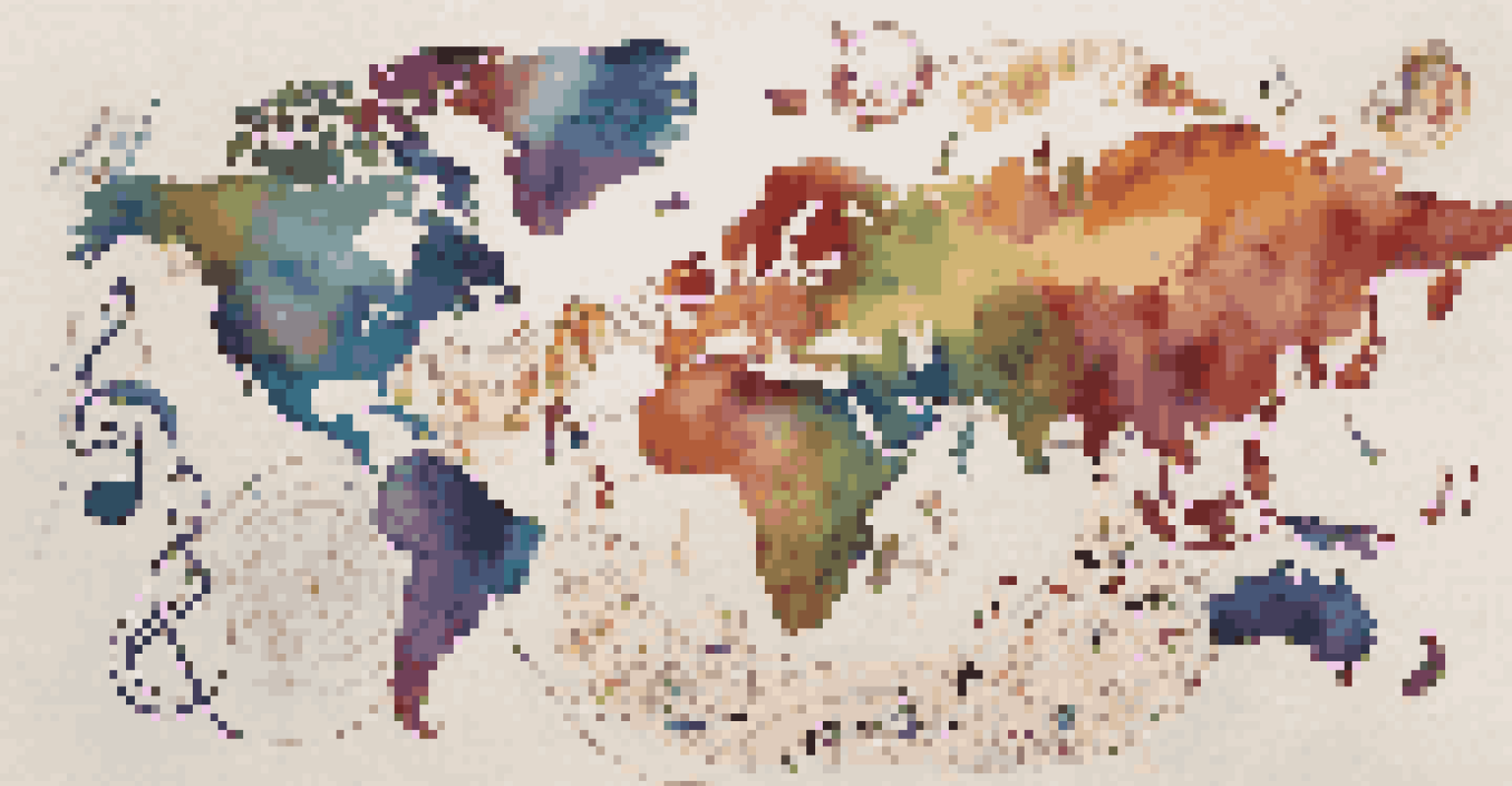The Influence of Digital Media on Music Genre Popularity

The Rise of Streaming Platforms and Genre Diversity
Streaming platforms like Spotify and Apple Music have revolutionized how we consume music. With millions of tracks at our fingertips, listeners can easily explore a vast array of genres, leading to increased genre diversity. This access allows niche genres, like indie folk or K-pop, to gain traction and find dedicated audiences worldwide.
Music is the universal language of mankind.
Moreover, these platforms often curate personalized playlists based on user listening habits, which helps introduce listeners to new genres they might not have explored otherwise. For example, someone who typically listens to pop might discover a passion for electronic music through a well-crafted playlist. As a result, genre boundaries blur, and artists from various backgrounds can reach a wider audience.
Ultimately, streaming platforms not only democratize music consumption but also encourage experimentation among listeners, fostering a culture where genre exploration is celebrated. This shift is crucial in shaping the popularity of emerging genres and reviving older ones that might have faded into obscurity.
Social Media: The New Music Discovery Tool
Social media platforms like TikTok, Instagram, and Twitter have become essential for music discovery and promotion. Viral challenges or trends can catapult a song into the mainstream, sometimes overnight. For instance, a catchy hook can lead to millions of user-generated videos, significantly boosting a song's popularity and its associated genre.

This phenomenon not only highlights the power of social media in promoting individual tracks but also showcases how genres can gain sudden popularity based on trends. A genre that was once niche can suddenly become mainstream, thanks to a viral moment. Artists are now more inclined to experiment with different styles to fit the ever-changing landscape of social media trends.
Streaming Platforms Boost Genre Diversity
Streaming services enable exploration of various genres, promoting niche styles and broadening listener access.
As a result, social media has transformed the music industry into a dynamic space where genres are constantly evolving. Artists leverage these platforms to create their own narratives, connect with fans, and share their musical influences, ultimately shaping the music landscape in real-time.
The Role of Influencers in Shaping Genre Trends
Influencers play a pivotal role in shaping music genre trends by leveraging their large followings to promote artists and songs. When a popular influencer shares a song, it can lead to a surge in interest and streams, allowing lesser-known genres to break into the mainstream. This dynamic creates a snowball effect, where the influencer's endorsement can lead to increased visibility for specific genres.
The beautiful thing about music is that it connects people.
For example, many hip-hop artists have found success after being featured in an influencer's post or video, showcasing how this modern marketing strategy can elevate genres quickly. Influencers often curate content that resonates with their audience, meaning they can introduce their followers to new sounds and styles that they may not have encountered otherwise.
As a result, the relationship between influencers and the music industry is increasingly symbiotic. Artists who align themselves with the right influencers can see their music gain traction, while influencers continue to expand their content's variety, keeping their audience engaged.
User-Generated Content and Genre Evolution
User-generated content (UGC) has become a driving force behind music genre evolution. Platforms like YouTube and TikTok encourage users to create their own interpretations of songs, leading to unique mashups and remixes that blend different genres. This creative collaboration can result in entirely new sounds, further diversifying the music landscape.
As fans engage with music in this participatory manner, they contribute to genre fluidity. A blend of pop and country might emerge from a viral dance challenge, pushing both genres into new territories. This shows how digital media not only promotes existing genres but also encourages the birth of new ones, reflecting the tastes of a diverse audience.
Social Media Drives Music Trends
Platforms like TikTok and Instagram can rapidly elevate songs and genres to mainstream popularity through viral content.
Consequently, artists are increasingly aware of this UGC phenomenon, often encouraging their fans to remix and share their music. Embracing this collaborative spirit can be beneficial, as it allows artists to tap into new audiences while keeping their music relevant in a fast-paced environment.
Globalization of Music Genres Through Digital Platforms
Digital media has facilitated the globalization of music genres, breaking down geographical barriers that once limited exposure. A listener in the U.S. can easily discover Afrobeat tracks from Nigeria or reggaeton from Latin America, leading to a rich tapestry of global sounds. This cross-pollination fosters an appreciation for diverse musical styles and influences.
Moreover, artists now have the opportunity to reach international audiences without the need for traditional gatekeepers like record labels. This accessibility allows for the rise of global music movements, where artists collaborate across borders and genres, creating innovative sounds that resonate with audiences worldwide.
This globalization not only enhances the music experience for listeners but also enriches artists' creative processes. As they draw inspiration from different cultures and genres, the music landscape continues to evolve, reflecting a more interconnected world.
The Impact of Algorithms on Music Genre Popularity
Algorithms play a crucial role in determining which songs and genres gain popularity on streaming platforms. These complex systems analyze user behavior, such as playlists and listening habits, to recommend music tailored to individual tastes. While this can enhance the listener's experience, it can also create echo chambers that amplify certain genres while sidelining others.
For instance, if an algorithm identifies that a user frequently listens to a particular genre, it will prioritize similar tracks, which can limit exposure to diverse sounds. This phenomenon can lead to a situation where mainstream genres dominate playlists, making it challenging for emerging genres to break through.
User-Generated Content Shapes Genres
Creative contributions from fans on platforms like YouTube and TikTok lead to genre evolution and the emergence of new sounds.
However, algorithms also have the potential to promote lesser-known genres if enough listeners begin to engage with them. As more users actively seek out diverse music, algorithms can adapt and help elevate these genres, showcasing the delicate balance between personalization and diversity in music consumption.
The Future of Music Genres in a Digital World
As technology continues to advance, the future of music genres looks promising yet unpredictable. The rise of virtual concerts, interactive music experiences, and advancements in AI-generated music will likely reshape how we perceive and engage with genres. Artists will have even more tools at their disposal to experiment and innovate, leading to exciting new sounds.
Furthermore, with the ongoing influence of social media and streaming platforms, we can expect genres to continue evolving at an unprecedented pace. Genres may become increasingly hybridized, as artists draw inspiration from multiple influences to create unique musical identities that resonate with diverse audiences.

Ultimately, the digital landscape will continue to play a pivotal role in shaping music genres, ensuring that they remain dynamic and relevant. As listeners, we're invited to embrace this evolution, exploring new sounds and celebrating the rich tapestry of music that awaits us.